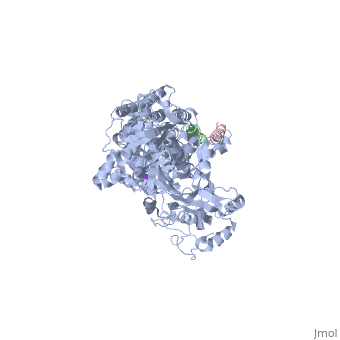Phospholamban
From Proteopedia
(Difference between revisions)
| Line 2: | Line 2: | ||
== Function == | == Function == | ||
| - | '''Phospholamban''' (PLB) is a 52-amino acid membrane protein that regulates the Ca+2 pump in cardiac and skeletal muscle cells. PLB functions as a homopentamer and is an inhibitor of Ca+2-ATPase in its unphosphorylated state. When PLB is phosphorylated by protein kinase A, it dissociates from Ca+2-ATPase and its inhibitory function is lost resulting in increase of ATPase activity. | + | '''Phospholamban''' (PLB) is a 52-amino acid membrane protein that regulates the Ca+2 pump in cardiac and skeletal muscle cells. PLB functions as a homopentamer and is an inhibitor of Ca+2-ATPase in its unphosphorylated state. When PLB is phosphorylated by protein kinase A, it dissociates from Ca+2-ATPase and its inhibitory function is lost resulting in increase of ATPase activity<ref>PMID:16317512</ref>. |
== Disease == | == Disease == | ||
| - | Mutations in PLB cause cardiomyopathy. | + | Mutations in PLB cause cardiomyopathy<ref>PMID:21167350</ref>. |
== Relevance == | == Relevance == | ||
| - | PLB is a key protein in the cardiac diastolic function. | + | PLB is a key protein in the cardiac diastolic function<ref>PMID:23907041</ref>. |
== Structural highlights == | == Structural highlights == | ||
Revision as of 09:13, 28 June 2016
| |||||||||||
3D Structures of phospholamban
Updated on 28-June-2016
1plp – hPLB cytoplasmic domain – human - NMR
1zll, 2hyn – hPLB - NMR
1fjk, 1fjp – PLB – pig - NMR
1n7l, 2lpf – rPLB (mutant) – rabbit - NMR
2m3b – rPLB - NMR
2kb7, 2kyv – PLB – Escherichia coli - NMR
4kyt – dPLB (mutant) + calcium pump – dog
4y3u – dPLB + calcium pump
References
- ↑ Nef HM, Mollmann H, Skwara W, Bolck B, Schwinger RH, Hamm Ch, Kostin S, Schaper J, Elsasser A. Reduced sarcoplasmic reticulum Ca2+ -ATPase activity and dephosphorylated phospholamban contribute to contractile dysfunction in human hibernating myocardium. Mol Cell Biochem. 2006 Jan;282(1-2):53-63. PMID:16317512 doi:http://dx.doi.org/10.1007/s11010-006-1171-7
- ↑ Landstrom AP, Adekola BA, Bos JM, Ommen SR, Ackerman MJ. PLN-encoded phospholamban mutation in a large cohort of hypertrophic cardiomyopathy cases: summary of the literature and implications for genetic testing. Am Heart J. 2011 Jan;161(1):165-71. doi: 10.1016/j.ahj.2010.08.001. PMID:21167350 doi:http://dx.doi.org/10.1016/j.ahj.2010.08.001
- ↑ Golden HB, Watson LE, Nizamutdinov D, Feng H, Gerilechaogetu F, Lal H, Verma SK, Mukhopadhyay S, Foster DM, Dillmann WH, Dostal DE. Anthrax lethal toxin induces acute diastolic dysfunction in rats through disruption of the phospholamban signaling network. Int J Cardiol. 2013 Oct 9;168(4):3884-95. doi: 10.1016/j.ijcard.2013.06.050. Epub, 2013 Jul 30. PMID:23907041 doi:http://dx.doi.org/10.1016/j.ijcard.2013.06.050

